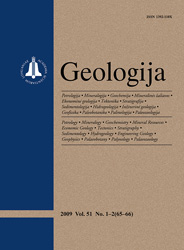Geologija / Geology
WHAT?
 ISSN 1392-110X ISSN 2029-056X (online) |
2011 m. Nr. 2 Hydrogeothermal resources of Middle Lithuania
The main geothermal prospects are related to West Lithuania, while the potential of Middle Lithuania was little considered before. The Cambrian sandstone reservoir was identified as a potential hydrothermal resource in Middle Lithuania. Other large-scale geothermal aquifers have too low temperatures. The study indicates that the effective thickness of the Cambrian geothermal aquifer of Middle Lithuania ranges within 15–58 m, the average porosity of sandstones is 13–20% and permeability averages 370 mD; therefore, these sandstones are classified as a good reservoir. The geothermal potential was calculated for geothermal well doublet. The productivity of the geothermal well doublet is estimated to be as high as 53–175 m3/h in the southern part of the study area, while reaching only 16–43 m3/h in the north. Accordingly, the geothermal energy production of the well doublet varies from 0.44 MWh to 1.37 MWh in the northern area, ranging from 1.69 MWh to 6.02 MWh in the south. The water of the Cambrian formation is of the NaCl type with a high salinity (98–130 g/l). The thermochemical modelling indicates that depending on water composition, either the precipitation of gypsum or carbonates and hydroxides should be expected in the geothermal system, while other major mineral phases remain unsaturated in the geothermal loop. Analysis of the available geothermal resources and their comparison with the heat energy needs of Middle Lithuanian customers indicate that one or two doublet installations exploiting the Cambrian geothermal aquifer may cover the basic needs in the central heating of towns in the region. It is concluded that the Cambrian geothermal aquifer is highly promising for district heating in Middle Lithuania. Keywords: geothermal, hydrothermal resources, Cambrian, hydrochemistry |
Issues:
2011 - Vol.53 No. 1, No. 2, No. 3 2010 - Vol.52 No. 1-4 2009 - Vol.51 No. 1-2, No. 3-4 2008 - Vol.50 No. 1, No. 2, No. 3, No. 4, No. Priedas 2007 No. 1, No. 2, No. 3, No. 4 2006 No. 1, No. 2, No. 3, No. 4 2005 No. 1, No. 2, No. 3, No. 4 2004 No. 1, No. 2, No. 3, No. 4 2003 No. 1, No. 2, No. 3, No. 4 2002 No. 1, No. 2, No. 3, No. 4 2001 No. 1, No. 2, No. 3, No. 4 |